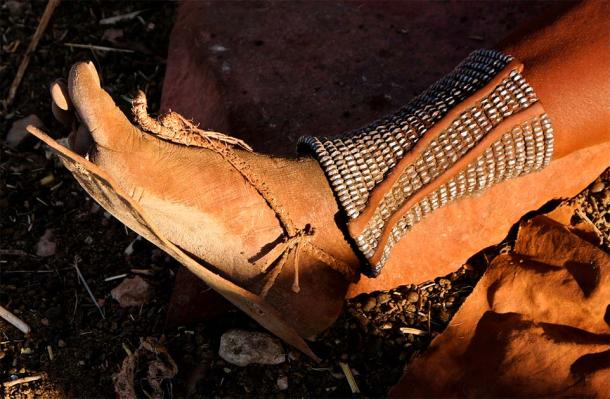
Ancient Humans May Have Worn Shoes 150,000 Years Ago!
The protective capacities of shoes are obvious, and would have been just as obvious in ancient times, when the earliest modern humans walked the earth. Nevertheless, researchers have long debated when exactly archaic humans would have developed the cognitive abilities to invent this most useful of all human innovations. A new study from the University of the Witwatersrand in Johannesburg, South Africa offers new and surprising evidence that will have an impact on this debate, since this evidence suggests that the earliest shoes may have been worn as long as 75,000—150,000 years ago, or way back in the Middle Stone Age.
To put in perspective what a remarkable discovery this is, up to now the oldest pair of shoes found in Europe are just 6,200 years old. As for South Africa, previous research suggested that people living in the lands of modern-day South Africa only began making and wearing footwear about 2,000 years ago. The thinking was that shoes in this part of the world wouldn’t have been as necessary as they were for those living further from the equator, since their feet wouldn’t have been as exposed to dangerous levels of cold.
But the story of how shoes appeared in southern Africa may now need to be rewritten, according to the paleoanthropologists from the University of the Witwatersrand’s Evolutionary Studies Institute who participated in this groundbreaking new research.
The evidence for ancient shoes they’ve produced comes from their analysis of a series of fossil markings found imprinted in three ancient rock surfaces along South Africa’s Cape Coast. The imprints resembled tracks made by some kind of shoe, and the researchers have provided persuasive data suggesting that this resemblance might be more than just coincidence.
“We all assumed that people were habitually barefoot [tens of thousands of years ago],” explained Dr. Bernhard Zipfel, in a University of the Witwatersrand press release. “However, the Southern Cape Coast had very sharp rocks at the time. It makes sense that people would use footwear to protect themselves. One hundred thousand years ago, an injury to the foot could have been fatal."
Geological dating techniques established an age for the imprinted surfaces of between 75,000 and 150,000 years ago, making it clear that these markings were indeed incredibly old. These areas likely would have been beach fronts in ancient times, the researchers believe.
- 2000-Year-Old Child’s Leather Shoe Found in Austrian Salt Mine
- The Everlasting Shoe: What Does This 5,500-Year-old Shoe Found in a Cave Tell Us About Ancient Armenians?

Evidence for ancient footwear comes from fossilized imprints that look like they were made by shoes (representational image). Public domain.
Finding the Needles in the Haystack (or the Shoe Tracks on Ancient Beaches)
Naturally, footwear in ancient times would have been made from comfortable yet durable organic materials, such as leather or plant materials. Over the course of many thousands of years the shoes themselves would have degraded and disintegrated, leaving shoeprints made by people walking across wet grounds (like along a beach) as the only real evidence that could prove such shoes ever existed.
Unsurprisingly, these kind of tracks are extremely rare and hard to find. And even when something intriguing is discovered, researchers can only discuss the probability that such markings are shoeprints, since absolute proof will always be lacking (there are no surviving samples of ancient footwear that can be definitively matched to such prints).
Up to now, only four sites have been found that meet the criteria for inclusion in the list of possible footprint sites from 30,000 years ago or earlier, all of which are in Western Europe (one of which was a Neanderthal site, fascinatingly enough). But research in the blossoming field of ichnology (the study of fossilized ground tracks or footprints left by animals or humans) is increasing, and the search for more evidence of human footwear from ancient times is growing rapidly. It was within the context of this development that the tracks along the South African coast were discovered, as researchers seek to learn more about ancient peoples’ behavior and movements through this type of intriguing evidence.
To verify that the tracks they analyzed were indeed shoeprints, the University of the Witwatersrand researchers created a few different types of simple footwear, similar or identical to what ancient peoples would have made and worn. They then put these shoes on and walked up and down along Cape Coast beaches, making a series of tracks in both wet and dry sand.

Ancient humans may have worn shoes made from animal skin or plant material. Source: Gorodenkoff / Adobe Stock.
Using computer-generated images of both the new and ancient tracks, the researchers were able to make comparisons that proved most enlightening. They identified three fossilized track sites on the Cape Coast that could very well have been made by humans wearing ancient footwear, between 75,000 and 150,000 years ago or during the Middle Stone Age. These tracks matched the modern recreations almost perfectly, which should be enough to make researchers everywhere reconsider what they thought they knew about the history of footwear.
Dr. Zipfel, who is both a paleoanthropologist and podiatrist by trade (a unique combination of occupations, to be sure), believes that the ancient human who made the tracks was wearing an extremely early form of what today are known as plakkies, or flip flops. Recent discoveries have shown that the San people (Bushmen), a surviving hunter-gatherer culture that has lived in southern Africa for at least 20,000 years, have been wearing comfortable but rugged sandals for a long time. It therefore stands to reason, Dr. Zipfel concludes, that ancient residents of the area would have worn shoes that were similar to these.
“It was important for these shoes to withstand environmental concerns,” he said.

The ancient shoes may have been an early form of plakkies or flip flops. Source: Michele Burgess / Adobe Stock.
Taking a Long Walk Back Through Time, in Comfortable Shoes
Even though this research is interesting and significant, the researchers acknowledge it won’t be accepted as definitive proof of anything. But they still consider their study to be a real breakthrough.
"While our evidence is inconclusive, we are pleased with our discoveries nonetheless,” Dr. Zipfel said. We also contribute to the research about when humans wore shoes … It is worth noting that the research findings strongly suggest that the region of southern Africa has been a hub for developing cognitive and practical abilities for an extended period."
Now that archaeologists and paleoanthropologists know that people may have been traveling along the coast of South Africa in footwear tens of thousands of years ago, they will be on the lookout for further evidence that confirms this theory. It is possible that tracks imprinted in rocks that would have been ignored or overlooked in the past will now be seen and properly identified, allowing for the truth about the ancient origins of shoes to finally be revealed.
Top image: An ancient shoe made from animal skin. Credit: German Mining Museum.
By Nathan Falde















